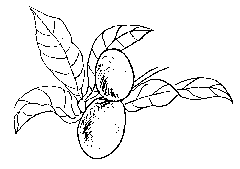Fruit Facts from
the
California Rare Fruit Growers, Inc.
Miracle Fruit
Synsepalum dulcificum Daniell
Sapotaceae
Common Names:
Miracle Fruit, Miracle Berry

Origin:
Tropical west Africa.
Adaptation:
Coming from hot, wet tropical lowlands, the plant is intolerant of
frost and should be considered a container plant except in southern
Florida and Hawaii. Older plants can survive a light frost but it is
best to avoid it if possible. Miracle fruit is a marvelous conversation
plant that does well in a container. Outdoors it is said to do best in
partial shade.
Description
Growth Habit: Miracle fruit is an evergreen bush or tree
growing to 18 ft. in its native habitat, but rarely to 5 ft. otherwise.
Foliage:
The plant has deep green, elongated leaves which grow in a spire-like
habit. Both regular and large-leaf and a hairy-leaf form are known.
Flowers:
The small 1/4 inch white flowers of miracle fruit are produced in
flushes through many months of the year.
Fruit:
The fruit is a small bright red, ellipsoid berry approximately 2 to 3
cm long and containing a single seed. Although not sweet itself, when a
single fruit is eaten and the fleshy pulp allowed to coat the taste
buds of the tongue and inside of the mouth, an extraordinary effect
occurs. The fruit will now allow one to eat a slice of lemon or lime
without wincing. The marvelous aroma and inherent sweetness of the
citrus remains but the sourness is almost completely covered. The
effect remains for some 30 minutes or more.
Culture
Location:
As an indoor plant, provide the plant with bright light such as a well
lit window. In the summer the plant can be moved with care to a warm,
lightly shaded spot.
Soils:
An acid soil is a must for miracle fruit. They prefer a soil acidity of
pH 4.5 to 5.8. This can be achieved by planting in equal parts Canadian
acid peat and pine bark. Also peat and perlite mixes are said to give
excellent result. In the basic soils of California, the plants slowly
die back until virtually only the stems remain. Allow the roots of the
plant to fill the container before transplanting into a larger one.
Irrigation:
Be sure that the soil is well draining as the plants do not like to sit
in wet soils. Coming from a tropical climate they need highly humid
conditions. When indoors, especially during the winter months, a small
clear plastic bag put around the plant and supported by wood or a wire
frame is helpful in maintaining humidity. Also, placing the plant
container on a tray with stones on the bottom and filled with water to
the top of the stones will add humidity to the local area. Misting the
leaves with good water also helps.
Fertilization:
Use a water soluble fertilizer such as Miracid and follow the label
directions. Use sparingly with frequency dependent on the growing
season, fertilizing more frequently during the summer months
Pruning:
In general, there is no need to prune the miracle fruit plant.
Propagation:
Propagation of miracle fruit is usually either by seed or cuttings. As
the seed viability is short, plant the cleaned seed immediately just
below the soil line When shipping cleaned seed for others to plant,
package in a small plastic bag and enclose a slightly moistened
toweling. Seed that are allowed to dry can be shipped for at least two
weeks but rapidly loose their viability.
Pests and
diseases: Watch for mealybugs, spider mites and other
indoor potted plant pests. Waterlogged plant will succumb to root rot.
Commercial
Potential:
The plant is not important as a food crop. Attempts to exploit the
striking effect on perception of sour flavors in development of
artificial sweeteners have not been successful but are continuing.
Cultivars
Hirsutus
A
form with hairy leaves introduced into Florida from Africa some years
ago. Small, oval, red fruits; larger than those of the common
smooth-leaf type.
Further
Reading
Facciola, Stephen. Cornucopia: a Source Book of
Edible Plants. Kampong Publications, 1990. p. 202
Martin, Franklin W., Carl W. Campbell and Ruth Ruberte. Perennial Edible Fruits of the
Tropics: an Inventory. U. S. Department of Agriculture,
Agriculture Handbook no. 642, 1987.
|
© Copyright 1996, California Rare Fruit Growers, Inc.
|